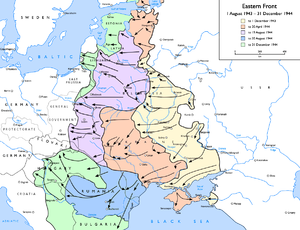Battle of the Crimea (1944)
| Crimean Offensive | |||||||
|---|---|---|---|---|---|---|---|
| Part of the Eastern Front of World War II | |||||||
 Red Army Offensives during 1943–1944 |
|||||||
|
|||||||
| Belligerents | |||||||
|
|
|
||||||
| Commanders and leaders | |||||||
|
|
|
||||||
| Strength | |||||||
| 462,400 men | Unknown | ||||||
| Casualties and losses | |||||||
| 17,754 killed and missing 67,065 wounded 84,819 overall |
57,500 killed and missing 39,200 wounded 61,580 captured 100,000+ overall |
||||||
The Crimean Offensive (8 April – 12 May 1944), known in German sources as the Battle of the Crimea, was a series of offensives by the Red Army directed at the German-held Crimea. The Red Army's 4th Ukrainian Front engaged the German 17th Army of Army Group A, which consisted of Wehrmacht and Romanian formations. The battles ended with the evacuation of the Crimea by the Germans. German and Romanian forces suffered considerable losses during the evacuation.
During late 1943 and early 1944, the Wehrmacht was pressed back along its entire front line in the east. In October 1943, the 17th Army withdrew from the Kuban bridgehead across the Kerch Strait into the Crimea. During the following months, the Red Army pushed back the Wehrmacht in southern Ukraine, eventually cutting off the land-based connection of 17th Army through the Perekop Isthmus in November 1943.
The Wehrmacht was able to successfully hold on to the Crimea even after it had been cut off by land due to their ability to supply it via the Black Sea. Holding the Crimea was considered important as its loss would negatively affect the attitude of Turkey and put Romanian oilfields under risk of Soviet air attacks. Aside from Soviet landings across the Kerch Strait and in the north-eastern sector near Sivash at the end of 1943, the Soviet Army largely ignored the Crimea for the next five months.
Paul Ludwig Ewald von Kleist was removed from command of Army Group A in March, 1944. There was no successor that replaced him. From then on Erwin Jaenicke theoretically controlled both 17th Army and Army Group A, though by this time the army group only consisted of the 17th Army.
An assault across the Perekop Isthmus was launched on 8 April by elements of the 4th Ukrainian Front's 2nd Guards and 51st Armies. The 17th Army defended but was unable to stop the advance. Kerch was reached by the Separate Coastal Army on 11 April; Simferopol, about 37 mi (60 km) northeast of Sevastopol, followed two days later. The 17th Army was retreating toward Sevastopol by 16 April, with remaining Axis forces in the Crimea concentrating around the city by the end of the third week of April.
...
Wikipedia
